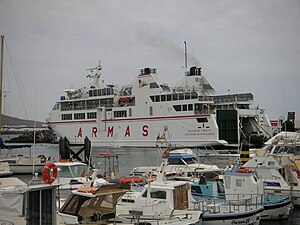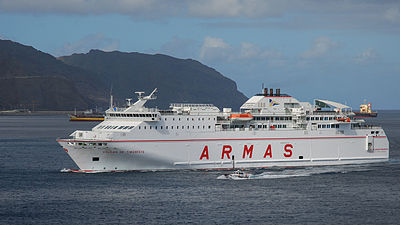
Funchal is the capital, largest city and the municipal seat of Portugal's Autonomous Region of Madeira, bordered by the Atlantic Ocean. The city has a population of 105,795, making it the sixth largest city in Portugal. Because of its high cultural and historical value, Funchal is one of Portugal's main tourist attractions; it is also popular as a destination for New Year's Eve, and it is the leading Portuguese port on cruise liner dockings.
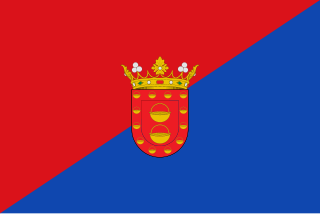
Lanzarote is a Spanish island, the easternmost of the Canary Islands in the Atlantic Ocean, 125 kilometres off the north coast of Africa and 1,000 kilometres from the Iberian Peninsula. Covering 845.94 square kilometres, Lanzarote is the fourth-largest of the islands in the archipelago. With 163,230 inhabitants at the beginning of 2024, it is the third most populous Canary Island, after Tenerife and Gran Canaria. Located in the centre-west of the island is Timanfaya National Park, one of its main attractions. The island was declared a biosphere reserve by UNESCO in 1993. The island's capital is Arrecife, which lies on the eastern coastline. It is the smaller main island of the Province of Las Palmas.
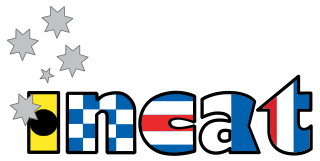
Incat Tasmania is an Australian manufacturer of high-speed craft (HSC) catamaran ferries. Its greatest success has been with large, sea going passenger and vehicle ferries, but it has also built military transports and since 2015 it has built smaller river and bay ferries. Based in Derwent Park, a suburb of Hobart, Tasmania, Australia, it was founded by Bob Clifford.
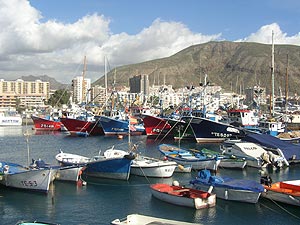
Los Cristianos is a town in Spain with a population of 21,235 (2017), situated on the south coast of the Canary Island of Tenerife. Located in the municipality of Arona between the cone of the mountain Chayofita and the greater mountain Guaza. The town centre is around the Los Cristianos bay, but is rapidly expanding inland with modern development. The town is a popular tourist resort and includes a ferry port and two beaches.
Trasmediterránea operates passengers and cargo ferries between mainland Spain and the Canary Islands, the Balearic Islands, and northern Africa's Spanish territories. Since 2017 the majority of the company belongs to Naviera Armas.
Fred. Olsen Express is an inter-island ferry service based in the Canary Islands, Spain. It operates a fleet of six modern fast ferries on five routes. Its fleet includes a trimaran fast ferry, the Benchijigua Express, which was the first such vehicle in the world when it entered service in 2005. The company is owned by the Olsen family-controlled Bonheur and Ganger Rolf, which among other things also owns the shipping companies Fred. Olsen Cruise Lines and First Olsen Tankers.

MV Madeleine II is a cruiseferry operated by the Canadian company Coopérative de Transport Maritime et Aérien (CTMA). It was previously operated by the Spanish company Trasmediterránea as the MV Villa de Teror.

The Madeira islands and Funchal have an extensive public transportation system. Travel between the two main islands is by plane or by ferries, the latter also allowing for the transportation of vehicles. Visiting the interior of the islands is now easy, due to major road developments, known as the Vias rápidas, on the islands during Portugal's economic boom.

Volcan de Teno is a high speed catamaran operated by Naviera Armas.
MV Volcán de Tacande was a ferry last owned by Naviera Armas, which was operated on routes around the Canary Islands. She was built by Brodogradiliste Jozo Lozovina Mosor, Togir, Yugoslavia in 1974 for Stena Ab, Göteborg as a roll-on roll-off car and commercial vehicle ferry, under the name Stena Nordica. It was launched on 17 June 1973.

MV Ocean Majesty is a cruise ship, originally built in 1966 as the ferry Juan March. The ship is now registered in the International Shipping Register of Madeira (MAR), Portugal.

FRS Iberia/Maroc are three independent companies operating under a single brand, one based in Morocco and the two others in Spain, founded in 2000 by their parent company Förde Reederei Seetouristik. The companies operate mainly in the Strait of Gibraltar with a fleet of eight ferries.
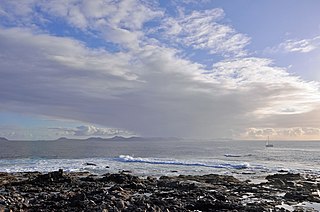
La Bocayna or La Bocaina is a sea strait that separates Lanzarote from Fuerteventura in the Canary Islands. The island of Lobos is situated on the southern side of the strait, close to Fuerteventura.

M/S Floria was a ferry ordered by Siljarederiet Ab in 1968 and constructed by Oy Wärtsilä Ab between 1968 and 1970. It was set to sail between Turku and Stockholm. The ship has a sister-ship called MS Botnia.

The Port of Funchal is the port and harbour of Funchal and is frequently used as a stop-over by transatlantic ships, en route from Europe to the Caribbean, as it is the northernmost Atlantic island that lies in the path of the Westerlies.

Bocayna Express is a catamaran fast ferry operated by the Spanish-Norwegian shipping company Fred. Olsen Express between the Canary Islands of Fuerteventura and Lanzarote in the Atlantic Ocean. It was delivered to Fred. Olsen in September 2003 and has been operating the route between the towns of Corralejo (Fuerteventura) and Playa Blanca (Lanzarote) since then. The ship is named after the Bocayna strait which separates the two islands it serves.
Volcán de Tagoro is a catamaran fast ferry operated by the Spanish shipping company Naviera Armas between the Canary Islands of Gran Canaria and Tenerife in the Atlantic Ocean. The ship's construction was completed in July 2019 and it commenced operations a month later, joining the two Canarian capitals, Las Palmas de Gran Canaria and Santa Cruz de Tenerife, in just over an hour and a half. The short journey time not only gives Armas a competitive edge in sea transport between the two islands, but also allows it to compete with flights.

Volcán de Tindaya is a roll-on/roll-off passenger ferry operated by the Spanish shipping company Naviera Armas between the Canary Islands of Fuerteventura and Lanzarote in the Atlantic Ocean. It was built and delivered to Armas in 2002 and has been operating the route between the towns of Corralejo (Fuerteventura) and Playa Blanca (Lanzarote) since then. The ship is named after the Tindaya mountain on Fuerteventura.


